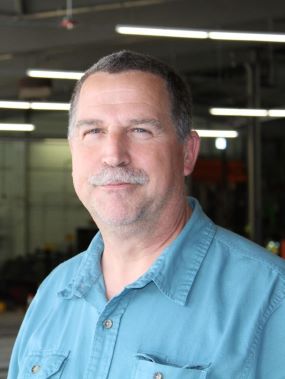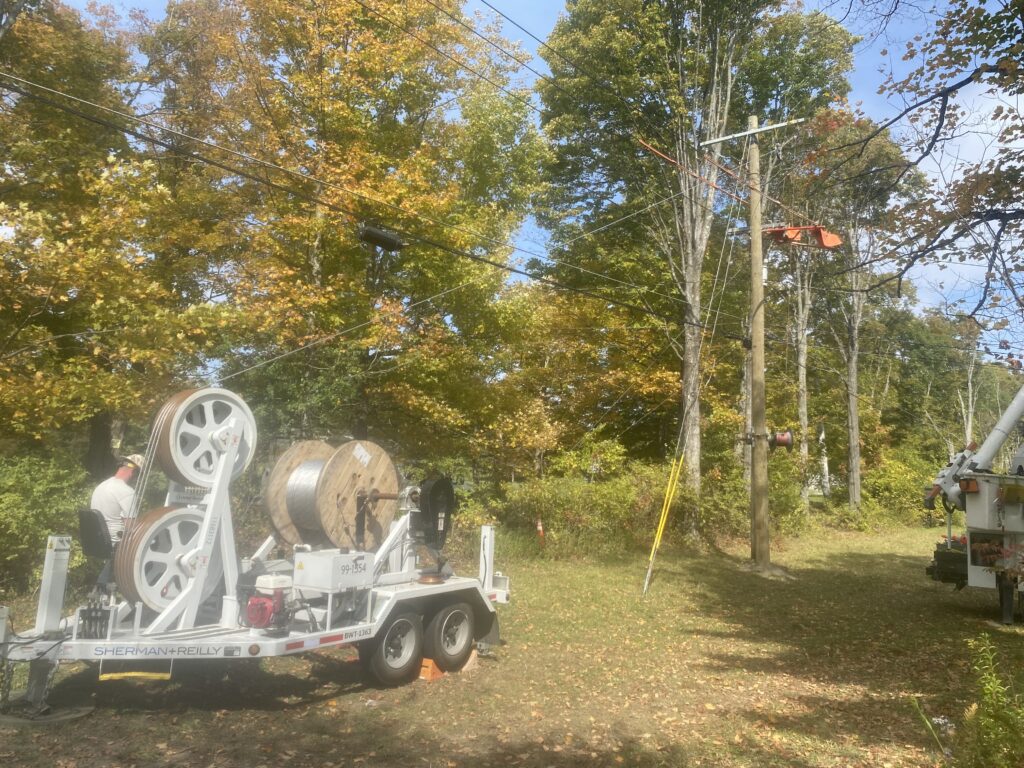FEMA mitigation grant supports line improvement using new tree-resistant cable

The goal is fewer outages on that section of line. Even if a tree lays on the wires, power should stay on. – Dave Kresock

In December 2022, Winter Storm Elliott left Washington Electric Cooperative with some of the worst storm damage of any cooperative in the country, including 41 broken poles and thousands of members without power. In East Montpelier, Bliss Road heads north, crosses Center Road, and continues as Barnes Road. Along this roadway, the storm left more than 160 member households without power for nearly three days.
“When we looked back after that storm,” said General Manager Louis Porter, “we identified several places we needed to strengthen, rebuild, and make more resilient to that kind of storm damage. That’s what this project is about: making this line less subject to damage from storms, more accessible to repair, and reducing the severity of outages.”
This year WEC won a FEMA hazard mitigation grant to upgrade the lines on Bliss and Barnes Roads. The project runs roughly 50 poles’ worth of line, starting at Green Road and continuing out to County Road, including the portion that crosses Center Road. The FEMA grant covers $588,000 of the $784,000 total project cost, with the Co-op borrowing the remaining $196,000 through the Rural Utilities Service (RUS).
This grant is different from disaster recovery grants in that it is intended to prevent damage from future storms. WEC is not usually competitive in winning this type of grant, Porter noted, because FEMA tends to privilege projects in high population density areas or that power critical infrastructure, like hospitals. That doesn’t describe WEC’s service area. “We’re lucky to qualify for this money and to do this project with nearly $600,000 that does not fall on our members,” said Porter.
The reason WEC was successful was because of the line’s importance—and vulnerability—within WEC’s grid, said Dave Kresock, Director of Engineering and Operations. “This particular line has 601 members on it from the substation out,” said Kresock. In addition to being a feeder line from the East Montpelier substation to smaller distribution lines, it connects a lot of sections of WEC’s grid. That means the Co-op also depends on it for backup: if a line fed by the nearby Maple Corner substation is out, Kresock’s Operations team can energize, or “backfeed,” it from the Bliss Road line. “So when it goes down, it affects a lot of people,” Kresock said. “FEMA looked at the cost-benefit and this was the project that rose to the top.”
Hendrix Spacer Cable
Instead of traditional open-wire crossarm construction, the rebuilt line uses Hendrix Spacer Cable. Three insulated conductors are supported by a high-strength messenger wire that also serves as the neutral. This construction holds the system compactly: a smaller strike zone, as Kresock put it. The system shrinks what used to be a ten-foot-wide strike zone down to a space about two feet across, significantly reducing the chance of direct hits from falling trees. And because the conductors are insulated, even a tree resting on the line often won’t cause an outage. “If a tree falls on it, in most cases the tree just stays there. The support messenger has an 11,000-pound breaking strength. It can take a beating,” Kresock observed.
Porter added, “We see so many more breaks in electrical wire than in communications wire because power lines are on top. With this, we’re putting something else up there to take the brunt of trees.”
“The goal is fewer outages on that section of line,” said Kresock. “Even if a tree lays on the wires, power should stay on. That means less time spent repairing, and when we do have to clear a tree, it’s often just a matter of cutting it off.”
Project Timing and Details
Because FEMA approval came late in the year, WEC had a narrow window to complete the work before the November deadline. “That urgency meant we didn’t have as much time to communicate with members in advance as we would have liked,” Porter acknowledged. “We’ve had some inquiries, and some members suggested we should have been in touch earlier. But between the federal timelines and approvals, there wasn’t much time.”
At the same time, Porter noted, “We heard from a lot of these members after the 2022 storm. They were upset about the length of outages. This project is exactly meant to reduce those kinds of outages and how long they last.”
For WEC, the Bliss Road project is something of a pilot. “We’ve never used Hendrix before on our system,” said Kresock. “Other utilities like GMP [Green Mountain Power] and Stowe have used it widely. It costs more than traditional construction, but it appears to be a worthwhile investment.”
The Co-op also plans to use Hendrix Spacer Cable on a 2.5-mile rebuild of a main feeder line in Greensboro. But Kresock emphasized the technology won’t be used on all lines, and that WEC’s mountainous topography means line upgrade decisions have to be made on a case-by-case basis. “It’s not something we’ll jump into whole hog. In some areas, underground might be better; in others, traditional construction. But in places like Bliss Road—off-road, hard to access—this design makes a lot of sense,” he said.
In addition to new cable technology, WEC is also replacing aging poles. Thinner, shorter poles installed in the 1970s are being replaced with stronger class 2 poles, which are designed to withstand heavier loads and last longer. This area of East Montpelier has a lot of ledge, so pole-setting requires subcontracting for special equipment to dig holes into the rock. Still, Kresock pointed out, digging holes is less expensive than digging a trench to underground wires.
One of the hardest parts about line upgrades for members, said Porter and Kresock, is that it often involves cutting trees. “Nobody likes having trees cut,” Porter said. “But it’s impossible to improve reliability without cutting trees. I hope members understand that in order to maintain the system, we have to cut trees and be on their property in rights-of-way. At the same time, we’re working to improve resilience in a way that impacts their rates as little as possible. This project is a good example: members are only on the hook for a relatively small portion of the cost.”
Kresock noted that outages have been relatively quiet so far this year. “But we can’t forget what 2022 was like,” he said. “We had a lot of storms, a lot of outages, and people were upset. You can’t have fewer outages without making these investments. That’s why we’re doing this.”
